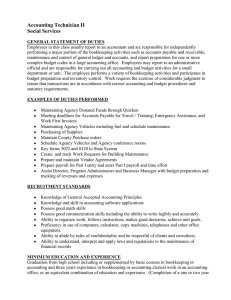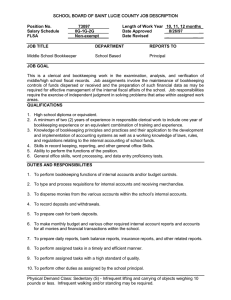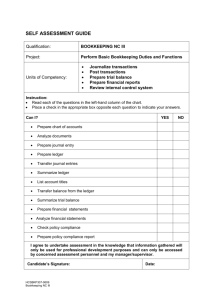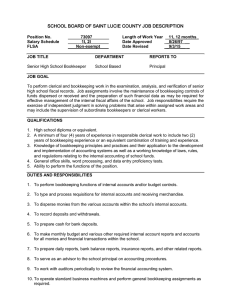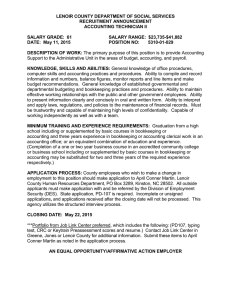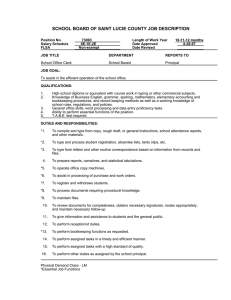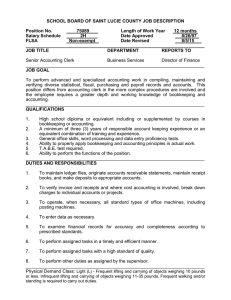COMPARING BOOKKEEPING AND FIELD SURVEY METHODS
advertisement
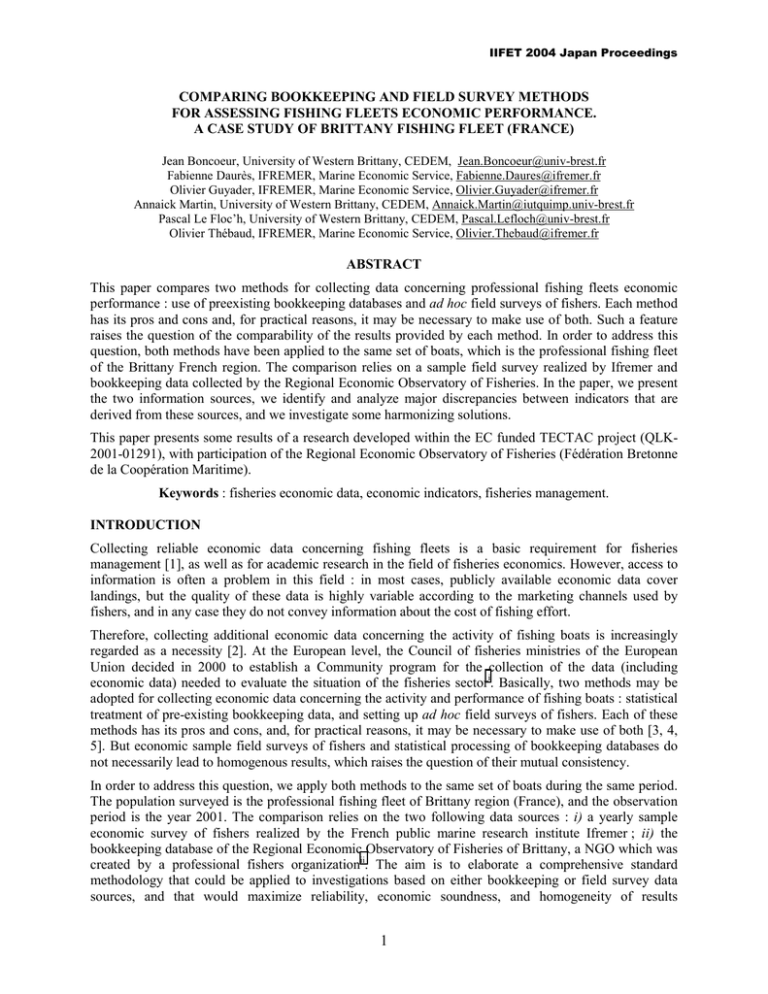
IIFET 2004 Japan Proceedings COMPARING BOOKKEEPING AND FIELD SURVEY METHODS FOR ASSESSING FISHING FLEETS ECONOMIC PERFORMANCE. A CASE STUDY OF BRITTANY FISHING FLEET (FRANCE) Jean Boncoeur, University of Western Brittany, CEDEM, Jean.Boncoeur@univ-brest.fr Fabienne Daurès, IFREMER, Marine Economic Service, Fabienne.Daures@ifremer.fr Olivier Guyader, IFREMER, Marine Economic Service, Olivier.Guyader@ifremer.fr Annaick Martin, University of Western Brittany, CEDEM, Annaick.Martin@iutquimp.univ-brest.fr Pascal Le Floc’h, University of Western Brittany, CEDEM, Pascal.Lefloch@univ-brest.fr Olivier Thébaud, IFREMER, Marine Economic Service, Olivier.Thebaud@ifremer.fr ABSTRACT This paper compares two methods for collecting data concerning professional fishing fleets economic performance : use of preexisting bookkeeping databases and ad hoc field surveys of fishers. Each method has its pros and cons and, for practical reasons, it may be necessary to make use of both. Such a feature raises the question of the comparability of the results provided by each method. In order to address this question, both methods have been applied to the same set of boats, which is the professional fishing fleet of the Brittany French region. The comparison relies on a sample field survey realized by Ifremer and bookkeeping data collected by the Regional Economic Observatory of Fisheries. In the paper, we present the two information sources, we identify and analyze major discrepancies between indicators that are derived from these sources, and we investigate some harmonizing solutions. This paper presents some results of a research developed within the EC funded TECTAC project (QLK2001-01291), with participation of the Regional Economic Observatory of Fisheries (Fédération Bretonne de la Coopération Maritime). Keywords : fisheries economic data, economic indicators, fisheries management. INTRODUCTION Collecting reliable economic data concerning fishing fleets is a basic requirement for fisheries management [1], as well as for academic research in the field of fisheries economics. However, access to information is often a problem in this field : in most cases, publicly available economic data cover landings, but the quality of these data is highly variable according to the marketing channels used by fishers, and in any case they do not convey information about the cost of fishing effort. Therefore, collecting additional economic data concerning the activity of fishing boats is increasingly regarded as a necessity [2]. At the European level, the Council of fisheries ministries of the European Union decided in 2000 to establish a Community program for the collection of the data (including economic data) needed to evaluate the situation of the fisheries sectori. Basically, two methods may be adopted for collecting economic data concerning the activity and performance of fishing boats : statistical treatment of pre-existing bookkeeping data, and setting up ad hoc field surveys of fishers. Each of these methods has its pros and cons, and, for practical reasons, it may be necessary to make use of both [3, 4, 5]. But economic sample field surveys of fishers and statistical processing of bookkeeping databases do not necessarily lead to homogenous results, which raises the question of their mutual consistency. In order to address this question, we apply both methods to the same set of boats during the same period. The population surveyed is the professional fishing fleet of Brittany region (France), and the observation period is the year 2001. The comparison relies on the two following data sources : i) a yearly sample economic survey of fishers realized by the French public marine research institute Ifremer ; ii) the bookkeeping database of the Regional Economic Observatory of Fisheries of Brittany, a NGO which was created by a professional fishers organizationii. The aim is to elaborate a comprehensive standard methodology that could be applied to investigations based on either bookkeeping or field survey data sources, and that would maximize reliability, economic soundness, and homogeneity of results 1 IIFET 2004 Japan Proceedings irrespective of the type of source used. This research is part of a EU funded project (TECTAC, QLK2001-01291), devoted to the analysis of factors influencing fishers long period and short period choices, and their consequences on fleets activity. We first present the case study, and we compare the representativeness of the samples provided by bookkeeping and field survey methods. We then make use of a common sub-sample to compare the economic indicators provided by each method, and analyze their mutual consistency. Finally, we summarize the results of our investigation, and suggest some harmonizing solutions. CASE STUDY AND REPRESENTATIVENESS OF SAMPLES In this section, we present the main population of the case study, the two sources of information that we use for investigating it, and the two samples which are derived from them. Main population The investigation is based on the case of Brittany professional fishing fleet during the year 2001. Brittany is the first French region as regards fishing industry, representing approximately 30-40% of that industry at the national level, according to indicators used (table I). Table I : Brittany and French professional fishing fleet, year 2001 Number of registered boats Number of fishers Cumulated HP (KW) Sales (106 euros) [A] Brittany [B] France [A] / [B] 1,641 8,983 359,653 356 5,686 25,548 915,021 1,066 29 % 35 % 39 % 33 % Source : French Ministry of Agriculture and Fisheries [6] The fishing fleet in Brittany is highly diversified, in terms of boat size, fishing areas, species targeted and gear used. Based on a typology designed by Ifremer, the following figure describes its composition, according to length class and main type of gear used. 350 300 250 200 Fixed gears 150 Other mobile gears 100 Trawlers 50 Purse seiners 0 <7m 7-12 m 12-16 m 16-24 m >24 m Figure 1. A view of the Brittany fishing fleet in 2001 : number of boats by length class and main gear used 2 IIFET 2004 Japan Proceedings During 2001, 1,609 professional fishing boats were active in Brittany. More than 1,000 of these boats were less than 12 meters long. At the other end, 105 boats were over 24 meters. As regards main gears used, the bulk of the fleet was composed of three main groups of boats : 573 trawlers (exclusive or mixed trawlers), 416 boats using other towed gears (mainly dredges), and 572 boats using only passive gears (nets, pots, lines). A specific group of 48 purse seiners was also found. Trawlers were met in all length classes over 7 meters, with a peak in the 16-24 meters class (213 boats). Contrasting with trawlers, most boats belonging to the two other major groups were under 12 meters, with a peak in the 7-12 meters class. Purse seiners are composed of two distinct subgroups : 20 north Atlantic purse seiners, most of them between 12 and 16 meters, and 28 tropical purse seiners, all of them over 40 meters. Sources of information One source of economic information concerning the Brittany fishing fleet is the accounting database of the Regional Economic Observatory of Fisheries, which was created in 1992 by a fishers cooperative organization (Fédération Bretonne de la Coopération Maritime). It is now jointly operated by this organization and a research unit of the University of Western Brittany (CEDEM), in partnership with the Regional Committee of Maritime Fisheries of Brittany (a professional organization entitled by law to participate in fisheries management at the regional level). The observatory collects yearly bookkeeping data provided by 12 bookkeeping groupsiii (covering 781 boats in January 2000)iv, and monthly landings data (limited to fish auction markets) provided by 3 producers organizations (covering 1,140 boats in January 2001). It publishes a yearly survey of the economic situation of the artisanal fishing fleets of Brittany [7], and realizes specific surveys for professional or academic purposes. An alternative source of information is provided by the economic field survey of a sample of fishers (boat skippers or owners)v realized at the national scale by Ifremer each year since 2000, and providing the basis for the economic component of the « Fisheries Information System » (SIH) developed by this institute [8]. This survey is based on an exhaustive analysis of boats activity calendars, which is used for partitioning the whole fleet into a number of sub-fleets, among which a random sample is chosen each year for the implementation of the field survey, with a goal of 15% for the sampling rate in each sub-fleet. Extracting the boats registered in Brittany from this national sample provides a regional sample which may be used for assessing the economic performance of the Brittany fishing fleet. Sample representativeness When comparing these two sources of information, the first question to be addressed is about the representativeness of the samples they rely on (these samples will hereafter be named as « bookkeeping sample » and « field survey sample » respectively). This question is considered here according to two criteria : boat length and main type of gear used (following the Ifremer typology of sub-fleets). Making use of these criteria, the two figures below compare the structure of the Brittany fleet in 2001 (main population) with the structure of the two samples. According to these figures, the correspondence with the main population structure is better with the field survey sample than with the bookkeeping sample, either in terms of boat length or activity. In both samples, the smallest and largest units are under-represented, but the distortion is heavier with the bookkeeping sample, which contains only a negligible number of boats under 7 meters or over 24 meters. Symmetrically, the bookkeeping sample displays an exaggerate concentration of 12 to 24 meters long boats (48% of the sample, but only 28% only in the main population), while the over-representation of this class is lighter with the field survey sample (34% of the sample). The distortions concerning activity are partly related with the ones concerning boat length, due to the fact that these two characters are not independent (see fig. 1 above). In this field, the most salient feature is the over-representation of trawlers in the bookkeeping sample (49% in the sample, against 36% only in the main population), which induces an under-representation of all other groups. By contrast, the activity-composition of the field survey sample is more in line with that of the main population. 3 IIFET 2004 Japan Proceedings <7m 7-12 m 12-16 m 16-24 m >24 m Fleet Field survey Bookkeeping 0% 10% 20% 30% 40% 50% 60% 70% 80% 90% 100% Figure 2. Comparative structure of fleet and samples by length class Purse seiners Trawlers Other mobile gears 0% 30% 50% Fixed gears Fleet Field survey Bookkeeping 10% 20% 40% 60% 70% 80% 90% 100% Figure 3. Comparative structure of fleet and samples by main type of gear used The reasons for the distortions between the composition of the samples and that of the population may be found in the way these samples have been set up. In the case of bookkeeping, the setting up of the sample did not involve any consideration of representativeness, and was simply the consequence of voluntary membership of boat-owners in the bookkeeping groups providing data to the Observatory (and of voluntary partnership between these groups and the Observatory). For historical reasons, it happens that the coverage of 16-24 meters trawlers by the Observatory is rather high. On the other side, few owners of very small units are members of bookkeeping groups, and fishing boats belonging to large corporate companies (which are generally the largest units in the fleet) do not participate in these groups. The situation is not the same with the field survey sample, which was specially designed with a concern for representativeness [9]. In this case, the sampling strategy relies on a targeted sampling rate of 15% in each boat category (defined in terms of length and activity), with possible exceptions for specific groups of boats (in the case of small groups, the targeted sampling rate may be higher, in order to get a statistically significant number of boats in the sample). However, practical difficulties may hinder the 4 IIFET 2004 Japan Proceedings fulfillment of the sampling target. One of these difficulties is the necessity to find enough skippers (or boat-owners) in each group who are willing and able to answer the survey questionnaire. For different reasons, this condition is seldom met with the smallest and largest units in the fleet. This constraint, together with the cost of implementing a field survey on a large scale, limits the size of the survey sample. At the scale of the Brittany region, the size of this sample was 258 units for the year 2001, against 545 (active) units in the bookkeeping sample. As a result, few categories of boats display a higher sampling rate with the field survey sample than with the bookkeeping samplevi (fig. 4). The most salient exceptions to this rule are found in the class of boats under 7 meters, where the coverage realized by the field survey is significantly higher than the one resulting from the bookkeeping approach. Field survey (n = 258) 100% 80% 60% 40% 20% 0% 0% 20% 40% 60% 80% 100% Bookkeeping (n = 545) Figure 4. Comparative sampling rates, by boat category (gear and length class) COMPARING OUTPUTS OF BOOKKEEPING AND FIELD SURVEY METHODS In this section, we compare economic data provided by bookkeeping and field survey methods. The analysis is focused on landings values, operating costs and gross surplus. In order to eliminate any statistical bias deriving from differences in the composition of the two samples, a common sub sample made of the intersection of the two original samples was set up. This sub sample (hereafter named as « common sample ») contains 127 boats. Its composition by length class and main type of gear used is presented in the following table. Table II : composition of the common sample <7m 7-12 m 12-16 m 16-24 m >24 m Total Purse seiners 0 0 3 0 0 Trawlers Other mobile gears Fixed gears 0 1 2 10 21 28 10 4 10 33 1 1 3 0 0 3 56 27 41 Total 3 59 27 35 3 127 Because of the limited number of boats in each of the two extreme length classes, only the group of boats between 7 and 24 meters long will be considered in the following comparative analysis. This group is made of 121 boats, which implies a global sampling rate of 9.5% of the corresponding population (1,276 boats), itself amounting to 80% of the whole regional fishing fleet. 5 IIFET 2004 Japan Proceedings All economic results presented in this section are derived from the common sample. The analysis is first conducted at the scale of the whole sample, then by length class. Finally, we present some tests concerning the sensitivity of economic performance indicators to measurement methods. Global comparison At the scale of the entire common sample (reduced to the 7-24 meters class), the following figure presents the results of each method concerning average annual values of landings, total current operating costs, and gross surplus. • • Operating costs : 9 Landing costs 9 Fuel and lubricant 9 Ice, food, gear 9 Labour costs 9 Maintenance & repair 9 Insurance 9 Misc. net costs Gross surplus = landings value operating costs Euros 350 000 Gap : + 1,2 % Bookkeeping 300 000 Gap : - 6,6 % 250 000 Field Survey 200 000 150 000 Gap : + 7,8 % 100 000 50 000 0 Landings value Operating costs Gross surplus Common sample, 2001 Figure 5. Comparing economic data : a global view of average results per boat (gaps are expressed as % of bookkeeping landings value) The first output of this comparison is a fairly high level of correspondence concerning average landings value : according to the answers of fishers to the field survey, this value is higher than the result given by the processing of bookkeeping data, but the gap between the two methods is only slightly over 1%. The gap is higher with operating costs and, as a result, with gross surplus. Gross surplus according to field survey is higher than according to bookkeeping, with a gap representing some 8% of bookkeeping landings value. In order to analyze the gap concerning operating costs, the following figure compares the composition of costs according to both methods. It appears that the bulk of the discrepancy between field survey and bookkeeping data derives from three categories of costs : boat maintenance and repair costs, labor costs, and miscellaneous net costs. Together, these three categories represent 95% of the total cost gap. In relative terms, the most important gap is due to miscellaneous net costs, which are 59% lower in the case of field survey than according to bookkeeping data. But this rate applies to a limited amount (no more than 2% of the cumulated operating costs), and, in absolute terms, the most important source of discrepancy relies in boat maintenance and repair costs : this item, which is 41% lower in the field survey results than in bookkeeping data, represents 57% of the total cost gap between the two data sources. The relative gap concerning labor costs is much more moderate (average labor cost according to survey data is only 3% lower than according to bookkeeping data), but the rate applies to a large amount, labor costs representing some 40% of total operating costs on the average. 6 IIFET 2004 Japan Proceedings 300 000 250 000 5 612 10 577 - 3 304 - 123 29 223 2 308 10 454 - 11 861 200 000 150 000 Common sample, 2001 127 696 17 362 123 350 - 4 346 Misc. net costs Insurance Mainten. & repair Labour costs Ice, food, gear 100 000 24 634 - 202 50 000 37 982 - 1 474 14 899 Fuel and oil 36 508 Landing costs 15 575 + 676 0 24 432 Bookkeeping Field Survey Figure 6. Comparative structure of average costs according to data source (euros) Before analyzing the causes of the discrepancies that have been noticed between the two data sources at the scale of the whole common sample, we proceed to an investigation by length class. Comparison by length class The following figure displays by length class the gaps concerning the average value of landings, total operating costs and gross surplus. In order to express these gaps in terms of a common relevant scale, we present them hereafter as percentages of bookkeeping landings value in each length class. 15% 10% Landings value Operating costs Gross surplus 16-24 m 12-16 m 5% 0% 7-12 m -5% -10% Figure 7. Gap between average estimations of landings value, operating costs and gross surplus, according to boat length class (Field survey - Bookkeeping, as a % of bookkeeping landings value) The figure above indicates an opposition between boats under and over 12 meters long. For boats under 12 meters, the field survey leads on the average to higher results than bookkeeping data, concerning both 7 IIFET 2004 Japan Proceedings landings (+6%) and costs (+4% of bookkeeping landings value). As a result, the average gap between the two data sources concerning gross surplus is limited : field survey estimation exceeds bookkeeping data by 1% of bookkeeping landings value on the average. For boats over 12 meters, field survey estimation of gross surplus also exceeds bookkeeping estimation, but the gap is larger : it represents 6% of bookkeeping landings value in the 12-16 meters class, and up to 11% in the 16-24 meters class on the average. Moreover, this gap is mainly due to costs, landings estimations being very close according to the two methods. In the case of boats over 12 meters, field surveys estimations of operating costs are systematically lower, not higher, than the corresponding estimations based on bookkeeping data. The average cost gap reaches 8% of bookkeeping landings value in the 12-16 meters class, and 10% in the 1624 meters length class. The following figure displays the cost gaps both by length class and by type of cost. 10% 7-12 m 12-16 m 16-24 m 8% 6% 4% 2% Maintenance & repair Fuel 0% -2% Landing costs Ice, food, gear Misc. net costs Insurance -4% -6% Labour costs Figure 8. Gap between average estimations of types of costs, according to boat length class (Field survey - Bookkeeping, as a % of bookkeeping landings value) According to the above figure, 3 categories of costs may be distinguished : i) labor costs, which are significantly higher according to field survey than to bookkeeping for boats under 12 meters, and display a symmetric gap for boats over 12 meters ; ii) boat maintenance & repairs costs, and miscellaneous net costs, which are systematically lower according to field survey than to bookkeeping data ; and iii) all other costs, for which the gaps between the two data sources are limited and have no permanent sign. Gap analysis The former subsections have led to the following results : 1. correspondence between field survey and bookkeeping data is generally good for landings value, except for the smaller boats (< 12 meters) where field survey data are generally higher than corresponding bookkeeping data ; 2. in all length classes, correspondence between the two data sources is fairly good for the following categories of costs : landings costs, fuel and lubricant, ice, food, bait, fishing gear and insurance costs (altogether, theses costs amount to approximately one fifth of bookkeeping landings value among smaller boats, and up to one third among larger boats) ; 3. in all length classes, field survey estimations of miscellaneous costs and of boat maintenance & repairs costs are lower than corresponding bookkeeping estimations (altogether, theses costs represent 7% or 8 IIFET 2004 Japan Proceedings 11% of bookkeeping landings value on the average, according to the data source which is used for their estimation) ; 4. concerning labor costs, field survey estimations lead to higher estimations than bookkeeping data for boat under 12 meters, and to lower estimations for boats over 12 meters long. The gap between field survey and bookkeeping estimations of average landings value for smaller boats, contrasting with a high level of correspondence for larger boats, may be related to the nature of marketing channels used by these boats. Marketing channels used by smaller boats are generally more informal than the ones used by larger boats. As a consequence, bookkeeping data often give a rough and incomplete view of sales for smaller boats, a feature which is reflected in the fact that, for these boats, field survey estimations of sales are 6% higher on the average than corresponding bookkeeping data. Concerning miscellaneous net costs and boat maintenance & repairs costs, the gap which is met in all length classes may be explained by two ways. First, it reflects the difficulty to get accurate and complete information by means of field survey concerning expenditures that are by nature diversified (this is typically the case with misc. net costs, an heterogeneous category made of a collection of small expenditures) and with an irregular time pattern. For this reason, it is realistic to assume that field survey estimations under-record reality concerning this type of costs. But the problem has a second side, concerning more specifically boat maintenance & repairs costs. A close examination at these costs leads to the conclusion than bookkeeping data sometimes include in this category expenditures which, from an economic point of view, should be considered as an investment rather than current operating costs. This feature reflects fiscal considerations, as well as a certain degree of fuzziness in bookkeeping conventions concerning the classification of expenditures in the fishing industryvii. It results in a probable overestimation of current boat maintenance & repairs costs by bookkeeping data. The opposite gaps concerning labor costs are mainly rooted in institutional problems. The cases of smaller and larger boats need to be examined separately. For boats under 12 meters long, field survey estimations generally lead to higher labor costs than bookkeeping data. Part of this gap may be explained by the sales gap (see above), due to the share system which is used in the artisanal sector of the fishing industry. But, paradoxically, a major source of discrepancy in the two data sources, for this length class (and more specifically for boats under 9 meters long), is due to the fact that the share system is not always used on small boats. In the French version of the share system, the skipper-owner of an artisanal fishing boat is normally rewarded through two channelsviii, which are the owner-share, and part of the crew-share (as a member of the crew). However, when the crew is composed of only one person (the skipper-owner himself), as is often the case on small boats, the share system is not always used, and the skipper-owner may be rewarded entirely on the basis of gross surplus. This institutional feature creates some heterogeneity in the accounting data of smaller boats, which sometimes include part of the skipper-owner’s income in the labor costs, and sometimes don’t. This heterogeneity is corrected in the processing of field survey data, a virtual crew share being computed (on the basis of usual rules in this field) when the share-system is not in use. It is not so with bookkeeping data, which simply reflect the institutional choices (here again influenced by fiscal consideration) made by each boat owner concerning the qualification of his professional income. As a result, average labor costs estimations derived from bookkeeping data under-record reality in the case of smaller boats. In the case of larger boats, we have seen that labor costs estimations derived from bookkeeping data are generally higher than the ones derived from field survey data. In this case, the origin of the gap does not rely in the share-system, which is in use on all boats of the sampleix, and determines the crew-share on the basis of sales and costs that are very similar in both types of data sourcesx. Examining the items which are included in bookkeeping data concerning labor costs leads to the conclusion that the gap with field survey estimations mainly relies in premiums, which are included in the bookkeeping definition of labor costs, but are generally not taken into account in field survey estimations. Two types of premiums are met : premiums to the crew (incl. skipper), and premiums to the boat-owner (who is usually also the boat- 9 IIFET 2004 Japan Proceedings skipper). If it seems relevant to include premiums to the crew in the category of labor costs, acting the same way with so-called premiums to the boat-owner is more questionable, since this type of income normally should be imputed on the owner-share. For this reason, one may consider that « real » wage costs in the case of boats between 12 and 24 meters long are somewhere between field survey and bookkeeping estimations : the former should include premiums to the crew, while the latter should not include premiums to the owner. Sensitivity tests The gap analysis suggests that alternative cost accountancy methods may significantly influence the view of fishing boats economic performance given by statistical data. In order to test this impact, four scenarios have been built and applied to the common sample : • scenario 0 is simply the actual situation (output of field survey and bookkeeping methods) ; • scenario 1 relies on the following assumptions : bookkeeping estimations concerning miscellaneous net costs are valid for all boats ; field survey estimations concerning labor costs are valid for boats under 9 meters ; bookkeeping data concerning crew premiums are included in labor costs of all boats ; bookkeeping data concerning owner premiums are excluded from labor costs of all boats ; • scenario 2A modifies scenario 1 by adopting field survey estimations concerning boat maintenance and & repair costs for all boats ; • scenario 2B modifies scenario 1 by adopting bookkeeping estimations concerning boat maintenance and & repair costs for all boats. The consequences of these scenarios on boat average gross surplus are presented in the figure below. Changing from scenario 0 (actual situation) to scenario 1, then to scenario 2A or 2B results in a progressive decrease in the gap between estimations of economic performance provided by the two sources of informationxi. This decrease is substantial : expressed in terms of landed value, the gap goes from 7.5% in scenario 0 to 4.2% in scenario 1, and to less than 0.5% in scenarios 2A and 2B. The absolute level of profitability is higher, whatever the source of information considered, in scenario 2A than in scenario 2B, due to the fact that accounting assumptions made in scenario 2A lead to lower estimations of boat maintenance and & repair costs than in scenario 2B. For reasons which have been detailed in the gap analysis, reality probably lies somewhere between scenario 2A and 2B. 30% Bookkeeping Field Survey 25% 20% 15% 10% 5% 0% Scen. 0 Scen. 1 Scen. 2A Scen. 2B Figure 9. Gross surplus as a % of sales : impact of scenarios concerning various accountancy assumptions 10 IIFET 2004 Japan Proceedings CONCLUSION In this paper, two methods for collecting economic information on fishing boats activity and performance have been compared : use of pre-existing bookkeeping data, and use of an ad hoc field survey of fishers. To this end, two samples of the same main population (the Brittany fishing fleet in 2001) were compared, and a common sub-sample was extracted from them in order to compare economic outputs of the two methods on an homogenous basis. The main results of the comparison may be summed up as follows : 1. the structure of the field survey sample was found to fit better to that of the main population than the structure of the bookkeeping sample ; 2. however, this advantage of the field survey method is partly balanced, in the case-study used, by a smaller sample size ; 3. applying the two methods to the common sample led to the conclusion that the correspondence was generally good for estimations of sales, with the exception of smaller boats for which bookkeeping data probably under-record reality ; 4. correspondence was also found to be good as regards various categories of costs : landings costs, fuel, lubricant, ice, bait, food, gear and insurance costs ; 5. substantial gaps were found for three categories of costs : labor costs, boat maintenance & repair costs, miscellaneous net costs ; for these three categories, the gap analysis provided explanations which, according to the sensitivity tests performed, cover the bulk of the difference between the levels of economic performance provided by the two methods. The results of these sensitivity tests also suggest some recommendations for harmonizing bookkeeping based and field survey based methodologies. A list of such recommendations would include : 1. set up homogenous rules for the accountancy of the skipper-owner’s income, whether the sharesystem is actually used or not (case of small boats with only one person onboard) ; 2. treat premiums the same way in field survey and bookkeeping estimations (preferably : include crewpremiums in labor costs, but not so with owner-premiums) ; 3. design and apply common rules for sorting out what type of expenditure related to boat maintenance & repair should be considered as current operating costs, and what type should be treated as an investment ; 4. rely as far as possible on bookkeeping estimations concerning miscellaneous costs that are difficult to catch precisely through a field survey of fishers. This list of harmonizing recommendations should not be regarded as complete. For practical reasons, it was not possible to investigate such costs as fixed capital depreciation or financial costs on the basis of the common sample presented in this paper. Concerning fixed capital depreciation, other surveys indicate that the gap between bookkeeping rules and economic reality may be important [11], due to the fact that bookkeeping rules are influenced by fiscal considerations that are not necessarily in harmony with the actual economic life span of fixed capitalxii. The problem is increased by the fact that the market value of a second hand boat incorporates, in France, the implicit value of the fishing rights that are attached to it and are de facto sold with it [12]. REFERENCES 1. FAO, 1995, Code of conduct for responsible fisheries, Rome, 41 p. 2. EC, 2001, Livre vert - L’avenir de la politique commune de la pêche, Office des Publications Officielles des Communautés Européennes, Luxembourg, vol I, 53 p., vol II, 131 p. 3. Anon., 2001, Data on economic performance of the fisheries sector - Final Report, EC Project n°00/32. 11 IIFET 2004 Japan Proceedings 4. Sabatella, E. and R. Franquesa, 2003, Manual of fisheries sampling surveys : methodologies for estimations of socio-economic indicators in the Mediterranean sea, FAO Studies and review, CGFM, n°73, 37 p. 5. Fodevareokonomisk Institut, 2003, Economic situation of the Danish Fishery 2003, Copenhagen. 6. Anon., 2002, Bilan annuel de production des pêches et de l’aquaculture, Ministère de l’Agriculture, de l’Alimentation, de la Pêche et des Affaires Rurales / OFIMER, Paris, 80 p. 7. Observatoire Economique Regional des Pêches, 2003, Résultats des flottilles artisanales 2001 / 2002, Fédération Bretonne de la Coopération Maritime, Quimper, 67 p. 8. Berthou, P., Daurès F., Merrien C., Leblond E., Guyader O., Jezequel M. and S. Bermell, 2003, Synthèse des pêcheries 2002 - Flotte mer du Nord-Manche-Atlantique, Ifremer, Brest, 80 p. 9. Van Isegem, S, Demanèche, S., Daurès, F., and O. Guyader, 2004, « Optimization of a sampling plan for economic data collection : application to the Atlantic French Fleet », paper presented to the 15th EAFE Annual Conference, Rome, April 2004. 10. Boncoeur, J., Coglan, L., Le Gallic, B. and S. Pascoe, 2000, « On the (ir)relevance of rates of return measures of economic performances to small boats ». Fisheries Research, 49 (2000), p.105-115. 11. Alban, F., Kervarec, F., Le Lec, G., Le Floc’h, P. and J. Boncoeur, Contraintes socio-économiques des navires goémoniers de la région Bretagne, étude réalisée pour le CRPMEM de Bretagne dans le cadre du programme d’initiative communautaire PESCA, rapport final, UBO-CEDEM, Brest, 105 p. 12. Guyader, O., Le Pellec, L. and F. Daurès, 2003, “A hedonistic analysis of capital stock in fisheries : the case of second hand market of the French fishing vessels”, XVth EAFE Conference Proceedings, Ifremer, Brest. i Council Regulation (EC) n°1543/2000, June 2000, establishing a community framework for the collection and management of the fisheries data needed to conduct the common fisheries policy (OJ L176, 15.07.2000). ii In order to protect confidentiality of individual data, the two databases have been processed separately by searchers of IFREMER on one side and CEDEM on the other side, and no individual comparison was made between them. iii Cooperative organisations in charge of legal accountancy duties for a group of members. iv Not all of them with complete valid economic data for the considered year. v In the French fishing industry, most boats are owned by their skippers. However, this is not so with the largest units. vi However, it is by no mean ascertained than the same feature would be met in other regions. vii By contrast, the situation appears clearer in the farming industry, due to the existence in this industry of a uniform system of cost assignment (Farm Accountancy Data Network) which, up to now, has no equivalent in the fishing industry. viii Contrasting with the UK version of the share system [10]. ix All boats of the common sample, and more generally all boats of the bookkeeping sample belong to the so-called artisanal sector of the fishing industry. x So called common costs, which are subtracted from sales for computing the crew-share and the owner-share, are usually the following : landings costs, fuel, food, bait and ice costs. The examination of data concerning these costs shows no major discrepancy between the two data sources used. xi This phenomenon is also met in all length classes of the common sample, with an exception for the 9-12 metres class due to the discrepancy concerning landings value that affects this group of boats. xii According to fiscal rules, complete depreciation of the purchase value of a boat may be accounted for in 6 years, notwithstanding the fact that 45% of the French fishing fleet was over 20 years old in 2001[3]. 12
